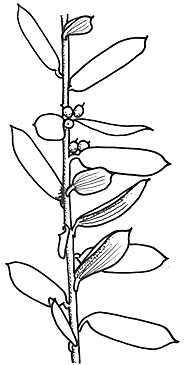Common name: Tree Broom-heath
Monotoca elliptica (Sm.) R.Br. APNI* Synonyms: Monotoca elliptica subsp. elliptica (Sm.) R.Br. APNI*
Monotoca elliptica subsp. albens (R.Br.) Albr. ms. APNI*

Description: Bushy shrub or robust small tree, usually up to 4 m, sometimes to 10 m high; branchlets minutely hairy.
Leaves erect to spreading, elliptic, oblong to oblanceolate, usually 10–25 mm long, 3–7 mm wide, margins entire; lamina glabrous, discolorous, lower surface often glaucous, flat, finely striate-veined; petiole 1–2 mm long, scabrous.
Flowers usually 4–16 together in terminal and axillary racemes often crowded at branch tips or occasionally solitary in upper leaf axils; peduncles 4–8 mm long; pedicels 0.5–0.7 mm long, silky; bracts ovate, scarious, mostly caducous; bracteoles c. 0.5 mm long. Sepals 1–1.2 mm long. Corolla tube campanulate, 2–2.5 mm long, glabrous, lobes 1.2–2 mm long, glabrous.
Fruit ovoid 3–4 mm long, orange or red.
Flowering: July–September
Distribution and occurrence: Grows in scrub or sclerophyll forest; widespread but most often on coastal dunes, inland to the escarpment ranges.
NSW subdivisions: NC, CC, SC, CT, ST
Other Australian states: Qld Vic. Tas.
Text by J. M. Powell, except for groups with contributors listed
Taxon concept: Flora of NSW 3 (1992)
ECOLOGY
Life History
Vegetative spread No.
Longevity Long-lived, more than 100 years. Some near Moore Park pre-date Centennial Park (M. Reed pers. comm.).
Flowers White--cream, July--October, peak August.
Fruit/seed Fleshy fruit (drupe), 3--4 mm long, orange or red, August--November.
Dispersal, establishment and growth Diaspore: fruit, probably bird-dispersed. Seedlings appear to establish in areas long unburnt. Germination slow and difficult, slow-growing (A. Bofeldt pers. comm.).
Fire response Resprouts from epicormic shoots (at La Perouse), though survival may be patchy. Most of population killed by high intensity fire (at Lane Cove River 1/1994), a few resprouting, no seedlings seen (P. Kubiak pers. comm.).
Interaction with other organisms Fruit eaten by Noisy Miners. Foodplant of butterfly larva Neolucia mathewi (Common & Waterhouse 1982).
Habitat
Habitat Headlandss, sand dunes, creekbanks.
Altitude 0--1000 m
Annual rainfall 1100--1600 mm
Typical local abundance Frequent--occasional.
Vegetation Eucalypt open-forest e.g. with Eucalyptus robusta, Angophora costata, Eucalyptus botryoides, low-forest and cliff-top scrub e.g. with Acmena smithii, Banksia integrifolia, Elaeocarpus reticulatus, Leptospermum laevigatum; riparian thicket e.g. with Tristaniopsis laurina, Backhousia salignus, Lomatia myricoides.
Substrate Coastal sand dunes, sandy soil over sandstone, low nutrients, well-drained.
Exposure Light shade (M. Robinson pers. comm.).
APNI* Provides a link to the Australian Plant Name Index (hosted by the Australian National Botanic Gardens) for comprehensive bibliographic data
***The AVH map option provides a detailed interactive Australia wide distribution map drawn from collections held by all major Australian herbaria participating in the Australian Virtual Herbarium project.
|


